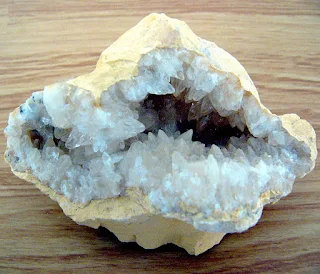White geodes are beautiful geological formations that look unremarkable on the outside but reveal sparkling crystal interiors when opened. These stones are admired by collectors, jewelers, and crystal lovers alike. But how much is a white geode actually worth? The answer depends on several factors—from its size and crystal type to overall rarity and condition.
 |
| Quartz geode from Morocco |
What Is a White Geode?
A white geode is a hollow rock, typically spherical or oblong, lined with white or clear crystals such as quartz or calcite. Formed over millions of years, geodes start as gas bubbles in volcanic or sedimentary rock, which eventually fill with mineral-rich water. Over time, these minerals crystallize, creating stunning interiors.
 |
| Quartz-kaolinite-iron oxide geode |
Average Price of a White Geode
White geode prices can range from $5 to over $500 depending on several factors. Here's a quick breakdown:
| Type | Price Range |
|---|---|
| Small, cracked geode | $5–$20 |
| Medium geode (4–6") | $25–$75 |
| Large decorative geode | $100–$300+ |
| Museum-quality specimen | $500+ |
Compared to high-end gems like fire obsidian, white geodes are generally more affordable, but large or rare ones can still fetch significant prices.
 |
| White crystal geode stone |
9 Key Factors That Affect White Geode Value
1. Size
Larger geodes, especially those with wide openings and dense crystal formations, are more valuable. A baseball-sized geode may be worth $20, while one the size of a bowling ball could command hundreds.
2. Crystal Type
Most white geodes contain quartz or calcite crystals. Quartz geodes tend to be more valuable due to their clarity and brilliance. Other minerals like celestite or apophyllite inside a geode can significantly increase its price.
3. Crystal Quality
The clarity, brightness, and symmetry of the internal crystals matter. Geodes with sparkling, well-formed points are worth more than those with dull or fragmented interiors.
4. Shape and Formation
A nearly perfect spherical geode with a uniform cavity is considered ideal. Unusual formations or ones with multiple crystal layers may also fetch a premium.
5. Rarity
Though white geodes are relatively common, rare inclusions, unusual patterns, or atypical formations (like stalactite growths) can drastically increase their value.
6. Location of Origin
Geodes from famous locations like Chihuahua (Mexico), Morocco, or Brazil may carry added value due to reputation and quality. U.S. states like Iowa and Utah are also known for collectible white geodes.
7. Whether It's Whole or Cut
Whole geodes cost less than cut ones because buyers can’t see the interior. Professionally sliced and polished geodes fetch higher prices, especially if both halves display vibrant, symmetrical crystals.
8. Market Trends
If geodes are trending on social media or among crystal collectors, their value can temporarily spike—similar to what happens with fire obsidian or aura quartz.
 |
| Quartz-kaolinite geode |
9. Presentation and Use
Geodes sold as home décor (e.g., bookends, table pieces) are often polished and mounted, increasing their retail price. Raw specimens bought for study or collection are usually cheaper.
White Geode vs. Fire Obsidian
While both are volcanic in origin, they are very different in value and appeal.
-
White geodes: Affordable, decorative, and widely available.
-
Fire obsidian: Rare, collectible, and prized for its metallic iridescence.
 |
| Geode (quartz inside) |
If white geodes are admired for their internal sparkle, fire obsidian is coveted for its fiery play-of-color—often demanding much higher prices per carat.
Buying Tips
If you're looking to buy a white geode:
-
Inspect interior clarity and sparkle
-
Ask about origin and mineral composition
-
Avoid dyed or overly treated geodes unless that’s your preference
Look for sellers who specialize in natural stones and provide accurate descriptions and images.
The value of a white geode depends on much more than just its size. The interior crystal quality, shape, and origin all play critical roles. While they may not command the price tag of rare gems like fire obsidian, white geodes are prized for their natural elegance, affordability, and the excitement of discovering hidden beauty inside what seems like an ordinary rock.
 |
| A close up of a slice of fruit on a table. Geode stone rock |
Whether you're a collector, decorator, or crystal enthusiast, knowing what determines a geode’s value can help you find the perfect piece for your collection—or recognize a great deal when you see one.
Common vs. Valuable
Common White Geodes: Small, common white geodes, especially those filled with clear or white quartz, can typically be found for just a few dollars.
 |
| Quartz-lined geode |
Valuable Specimens: Larger, high-quality white geodes, particularly those with exceptional crystal formations, or from rare locations, can be worth hundreds or even thousands of dollars. This applies to geodes with a significant amount of white calcite or clear quartz crystals within, as opposed to a thicker outer rock layer.
Determining the Value of Your Geode
Consult a Geologist: A geologist can examine your geode's size, crystal quality, and origin to help you determine its value.
Online Marketplaces: Search online marketplaces like eBay or Etsy for similar white geodes to get an idea of current market prices.
Rock and Mineral Clubs: Joining a local rock and mineral club can connect you with experienced collectors who can offer valuable insights and estimations.
Antique Shops and Collectors: These sources can also be helpful for their market knowledge and rough valuations.
 |
| Quartz-barite geode |
The value of a geode can fluctuate based on market demand and the subjective preferences of collectors. While a geode may be valuable in a monetary sense, it can also hold significant personal or sentimental value for the owner.
